A SOCKS5 (SOCKet Secure version 5) proxy is a type of proxy server that sits between you (source) and destination (web app or site). The proxy acts as an intermediary— intercepting all traffic between source and destination.
A SOCKS5 proxy server is a great alternative to a VPN, as it also “intercepts” and protects the traffic from exposing information at the destination. The SOCKS5 proxy masks the IP of the source with its own and forwards the source request to the right destination using its own IP.
One benefit of masking your IP with an intermediary such as a proxy SOCKS5 is that it protects your online anonymity. Another advantage is when the proxy is physically located in an offshore data center (and not locally), so the user can access geo-restricted content, like Netflix or Hulu, or bypass censorships.
1. What is SOCKS5?
SOCKS is a network protocol based on the old Secure Sockets to tunnel traffic through a server. The protocol was designed to improve client-server applications using TCP or UDP connections. With SOCKS, you can route any type of traffic (TCP or UDP) created by any application through a proxy server.
SOCKS works at the session layer (layer 5 of the OSI model). Since SOCKS works between application layers (7) and TCP/UDP (4), it can handle different types of requests, including HTTP, FTP, SMTP, etc., and applications like P2P, web browsing, email, and more.
The SOCKS server uses TCP port 1080 to accept incoming connections.
What does a SOCKS5 proxy do?
The SOCKS5 proxy server acts as the intermediary between two different networks (i.e. private and public). SOCKS5 on your local computer simply takes your app’s traffic and routes it through a proxy server on the Internet.
The SOCKS5 client (such as a web browser HTTP, or P2P platform) opens a TCP (or UDP) connection to the proxy server. Then, the SOCKS proxy server establishes a new (TCP or UDP) connection with a new IP address to the target website or app’s server.
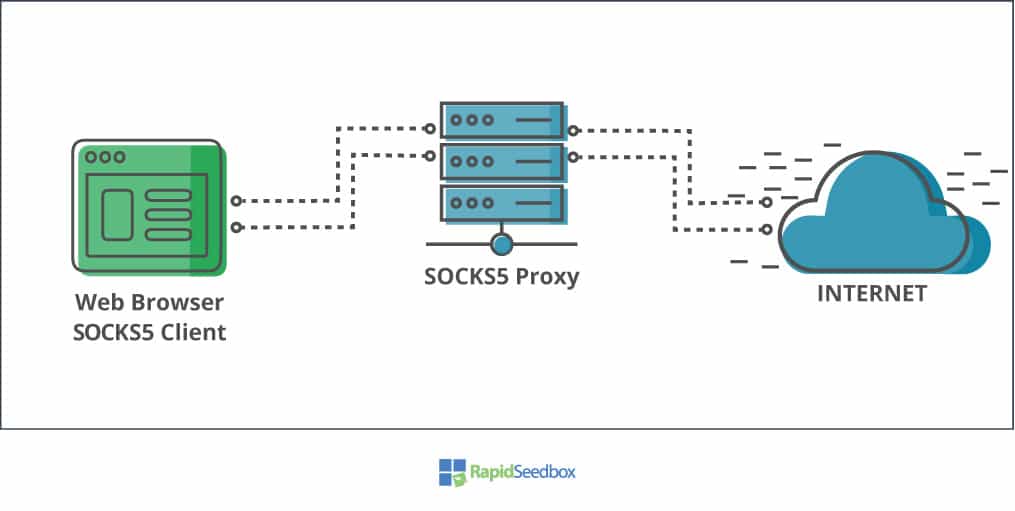
The most common use case of SOCKS5.
One of the most popular use cases of SOCKS is to facilitate the administration of network firewalls. As you might already know, firewalls block IP-based traffic but, when deploying a SOCKS proxy within a firewall, traffic can be allowed. The protocol establishes a TCP session (or UDP) through the firewall allowing source and destination, free communication through the firewall. Internal users can go through the firewall via the SOCKS5 proxy, without needing to modify firewall rules. Additionally, access to this “tunnel” can be restricted via authentication or IP.
SOCKS4 vs SOCKS5?
- SOCKS4 is the older version. It does not support authentication nor UDP connections.
- SOCKS5 is approved by the IETF under RFC 1928. It is an optimized version of SOCKS4, which supports a variety of authentication methods and provides means to forward UDP packets.
- SOCKS5 is significantly more secure. It can establish a TCP connection with authentication, so only authorized users can access the proxy server. Additionally, it can use Secure Shell (SSH) encrypted tunneling to enhance security.
SOCKS5 vs HTTP Proxy?
HTTP (or HTTPS) proxies were built to handle a specific type of traffic. They are high-level types of proxies because they only work with HTTP or HTTPS protocols, so they can only be used through your web browser. HTTP proxies can forward requests and in some cases modify certain headers, such as User-Agent, X-Forwarded-For, Via, etc). HTTP proxies do not offer any type of authentication.
SOCKS proxies are considered lower-level, as they can take almost any type of traffic or protocol. These types of proxies are suitable for a wide number of applications. Additionally, the fact that SOCKS5 can forward TCP and UDP traffic, and can be used with authentication, makes them completely different from HTTP proxies.
HTTP Proxy vs SOCKS5 Comparison Table:
| Proxy. | Type | OSI Layer. | Header Modification ? | Type of traffic | Ports | Security. |
| SOCKS5 | Low-level | Session (Layer 5) | No | Any traffic, or protocol. | Any port. | Authentication |
| HTTP | High-level | Application (Layer 7) | Yes | Only HTTP or HTTPS (Web browsers) | Ports 80 and 443. | N/A |
3. What Are The Benefits of a SOCKS5 Proxy?
SOCKS5 has more flexibility and security than other types of proxies. Generally, you could use a SOCKS5 proxy server when you need to achieve the right balance between two desirable (but often incompatible features): anonymity and speed.
Another advantage of the SOCKS5 proxy is that you can use it for any type of traffic (TCP or UDP). You can selectively hide specific portions of your traffic (based on the app), from TCP-based connections like HTTP, email, SSH, or FTP and in some cases, even UDP-based connections like games, DNS, or VoIP.
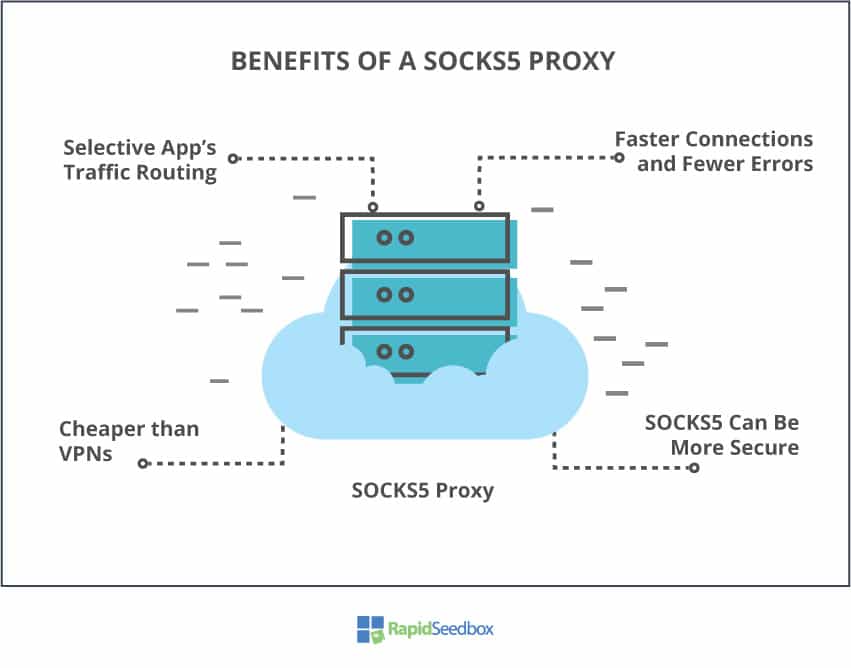
a. Faster Connections With Fewer Errors.
Proxies like the Anonymous HTTP Proxy, remove pieces of a header to avoid getting identified with a request. Other more advanced proxies may also change the header to employ another underlying protocol (such as FTP). All of these changes usually result in more errors.
The advantage of SOCKS5 proxies is that they do not rewrite data packet headers. Not having this additional overhead, makes their packets relatively smaller and easier to process. So there are fewer chances of errors, which ultimately lead to better performance and speed. Still, the only downside is that headers traveling back and forth are more exposed to data breaches (there’s no built-in encryption).
b. SOCKS5 Proxy can be Made More Secure.
Dedicated (non-shared) SOCKS5 proxies can be configured to be as secure as a VPN Server. For example, by implementing a private SOCKS5 with an SSH encrypted tunnel, you can drastically improve the security of a SOCKS5 proxy.
Still, keep in mind that the SOCKS5 is just a transport protocol, and by itself does not provide encryption. The SOCKS5 simply proxies (as transparently as possible) your traffic through another connection. Still, encryption is possible with SOCKS5, but it needs to be handled by the application itself, such as a browser (SSL/TLS) or OpenSSH (SSH).
Encryption via SSH?
With SSH, all traffic including that from SOCKS5 can be configured to go from the SSH client, through the private SSH encrypted tunnel, to a remote SSH server. This can help you hide traffic and bypass more intelligent (L7-DPIs) firewalls. Bear in mind that this deployment requires advanced configuration skills.
c. Selective app’s traffic routing.
A VPN works at a lower layer (Layer 3) which can be good for convenience and top-level privacy. With a VPN, all Internet traffic gets routed through the VPN interface and onto the encrypted tunnel. Still, there are some cases where you might need to separate an app’s traffic. For instance, if you are connected with a VPN and currently downloading a large HTTP file. You might need to use your original IP for some reason, like authentication or accounting, and you can’t disconnect from the VPN until the download is finished.
SOCKS5 proxy solves this problem because you can “selectively” route Internet traffic.
Since a SOCKS proxy works at a higher level, you’ll need to configure each relevant application (software) to route its Internet traffic through the SOCKS5 proxy. For example, configuring Chrome web browser to proxy all its HTTPS traffic, or a P2P platform like uTorrent to use the proxy’s IP to participate in a torrent swarm.
4. What can you use a SOCKS5 for?
Use a SOCKS5 proxy…
- If you are an individual end-user looking for the right trade-off between anonymity and speed. If you need to handle non-sensitive data that requires speed such as P2P, streaming, gaming, etc. Also, if you are looking to bypass geo-restricted content (such as Netflix) or censorship (from large networks or governments).
- If you are looking for a more comprehensive proxy solution for a company or large business, a SOCKS5 proxy can be useful to connect remotely to internal networks and help bypass the firewall (with authentication). Also, a SOCKS5 proxy can be used for data scraping, SEO campaigns, Social Media Marketing, test websites and ads, threat hunting, and more.
Let’s define some popular use cases:
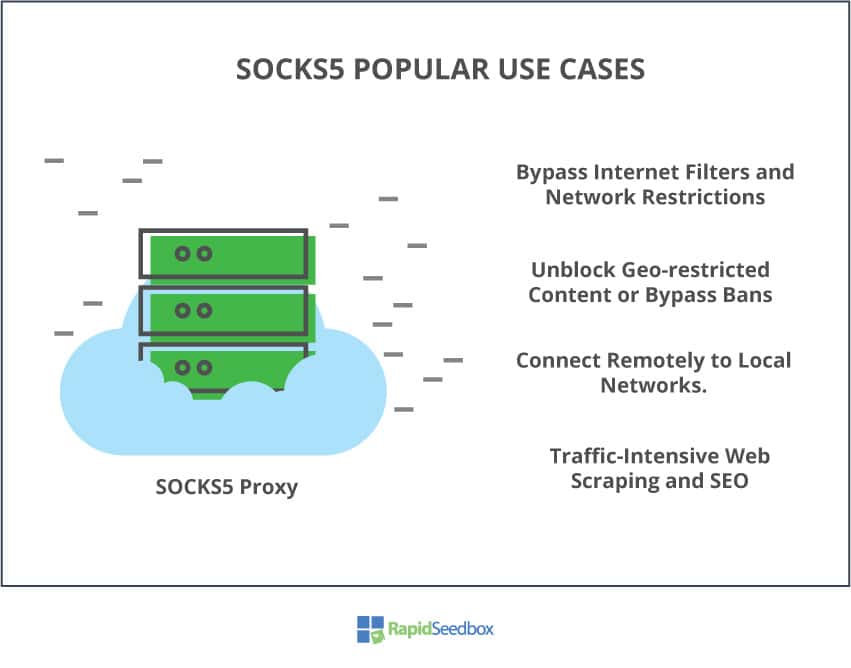
Bypass Internet Filters and Network Restrictions.
A SOCKS5 proxy allows you to circumvent local Internet restrictions or censorships created by governments, schools, or workplaces. Any firewall filtering traffic between source and destination will most likely have no idea of the SOCKS proxy (unless it is intended and controlled), so it will allow traffic to flow to the proxy.
Bear in mind that some advanced firewalls and DPIs will detect and filter layer 7 (L7) traffic, especially at the ISP or Government-level. An L7 firewall will inspect packets at the app level, which means (since data is not encrypted), it could detect the destination your packet is going towards.
Unblock Geo-restricted Content or Bypass Bans.
A SOCKS5 proxy also helps you circumvent remote restrictions from applications and websites defined by geo-restrictions, bans, or blacklists. For example, a geo-restriction can be imposed by a web service like Netflix, to tailor the access to their content, based on incoming geography (or country). For example, if you are in Brazil, you can only watch Brazil’s Netflix, or if you are in India, you can only watch Indian Netflix.
The proxy server (in another country) serves as an intermediary between your device and a destination (such as a webserver), so it helps circumvent remote service restrictions. For example, if you don’t want your IP getting blocked (or if it already has), or the VPN server provider’s IPs are also blacklisted from a specific online service— then, routing traffic through a SOCKS5 proxy will help bypass these restrictions.
Connect Remotely to Local Networks.
A SOCKS5 proxy can be used for remote users wanting to securely access an internal network. Setting a local SOCKS5 proxy with authentication will help establish inbound connections from the Internet to the internal network.
But that is not all, you can also use other applications to encrypt SOCKS traffic. For example, you can use tools like OpenSSH. SOCKS5 is built into OpenSSH, so it will run over through the SSH encrypted connection. The local SOCKS5 proxy will also help you with dynamic port forwarding.
Traffic-Intensive Web Scraping and SEO.
SOCKS5 proxies are ideal for traffic-intensive tasks like web scraping and SEO campaigns. Web scraping software automatically explores sites, extracts unstructured data, and provides structured results. Using proxies to scrape web data is the best way to bypass detection. For example, a rotating IPv6 proxy will help you bypass detection from anti-data-scraping technology and will produce efficient, error-less, and fast results.
Although you could also scrape web data with an HTTP proxy, the SOCKS5 proxy goes beyond as they let you scrape data from any TCP or UDP connection. You could scrape data from video streams, VoIP calls, etc.
SOCKS5 vs VPN.
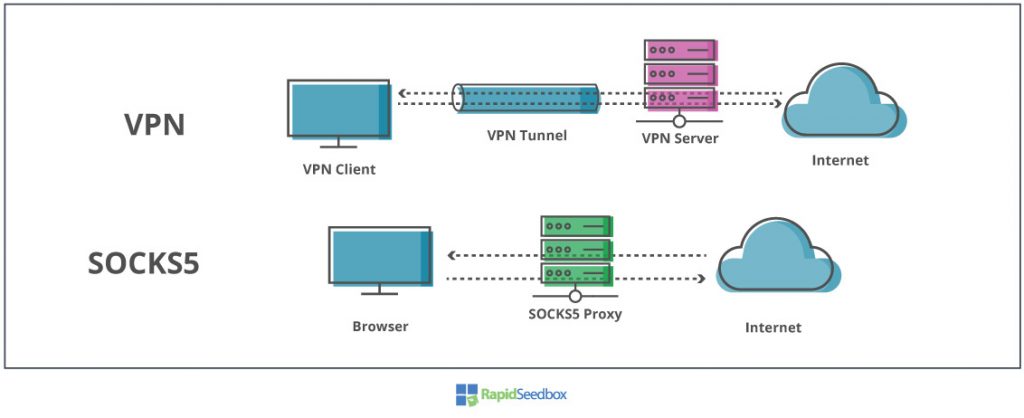
A SOCKS5 proxy is a top alternative to a VPN. Both technologies (SOCKS5 and VPN) can be used to centralize traffic from distributed, remote, and complex networks while keeping your online activity anonymous.
Still, VPNs and proxies are completely different technologies— designed for different purposes. The clearest distinction between SOCKS5 and VPNs is that a SOCKS5 proxy doesn’t encrypt traffic, while VPNs do. For more on this, check out our comprehensive comparison between VPNs vs Proxy.
VPN vs SOCKS5 Comparison Table:
| Technology. | OSI Layer. | Encryption | Security | Type of traffic | Speed | Security. | Price |
| SOCKS5 | Layer 5 | Only with SSH, HTTPS, etc | Only authenticates. | App-level | Faster than VPN | Changes IP | Cheaper than VPN |
| VPN | Layer 3 | Built-in | Encrypts data. | Entire Internet connection | Slower than a proxy. | Changes IP | More costly than a proxy. |
What is better: a VPN or proxy?
Again, both technologies were created for different purposes, so which one is better? depends on your requirements and resources. Each piece of technology can be better for different circumstances.
When to Use SOCKS5 Proxies or VPNs?
Both technologies should be able to bypass certain levels of firewall rules. Still, a VPN encrypts the entire connection, making them more secure than proxies. VPNs are better for bypassing Internet restrictions, censorship, and overall for handling more sensitive data (banking, trading, etc). On the other hand, SOCKS5 proxies can provide better anonymity levels than other types of proxies, and more speed than VPNs. A SOCKS5 proxy is also good when you need to bypass geographical restrictions, need anonymity, but speed is crucial for your application, (torrenting, streaming, gaming, etc.)
Can you use a SOCKS5 proxy with a VPN?
Although you could route your “proxied traffic” through a VPN tunnel, and use the VPN server as an Internet exit node to connect to the proxy, the only benefit you would get is a more obscured identity. For example, if your VPN connection shuts off, the IP revealed in the destination will be the proxies (and not yours)— this is somehow similar to the “Kill Switch” functionality found on modern VPNs.
A drawback of this “SOCKS5 via VPN” configuration is the substantial decrease in network speed. The more “stops and detours” you put in the way of your traffic, the more your connection speed will drop.
SOCKS5 Proxy vs VPN for Torrenting and P2P.
Both technologies will hide your P2P activity in some way or the other.
- Hiding P2P data (protocols and port) from local ISP. A VPN will encrypt data (at layer 3), so your ISP will not be capable of identifying P2P traffic and the destination IP will be the VPN server and not the torrent tracker. If you are using a SOCKS5 proxy, your ISP could identify your P2P traffic.
- Hiding IP from the torrent swarm. Both, the VPN and the SOCKS5 proxy server’s IP will be shown in the torrent swarm. So, no copyright enforcement or troll spying torrent swarms will be able to get your real IP address.
- Speed. When it comes to speed, SOCKS5 does encrypt data, so it can be much faster than VPN for P2P.
What is cheaper, VPN or SOCKS5 proxy?
SOCKS5 proxies require less infrastructure to work than VPN technology— therefore tend to be cheaper. First, there is no need to have SOCKS5 client software (as you would in VPNs), as all you need to do is configure the application with proxy information, like IP address, protocol, and port. Additionally, proxies work fine with IPv6 addressing (which are cheaper than IPv4s), VPNs on the other hand have potential data leaks if used with IPv6 (or dual-stack).
How Can You Get Started with a SOCKS5 Proxy?
To use a SOCKS5 proxy on your computer, all you need to do is provide the proxy’s information, such as IP address (or hostname), protocol (SOCKS5), port number, and authentication credentials (if necessary).
Configure SOCKS5 on a macOS.
To configure SOCKS5 Proxy Server in a macOS for your default browser, you need to go to System Preferences > Network > (choose your interface) > Advanced > Proxies.

Configuring SOCKS5 on a Windows.
To configure a SOCKS Proxy Server on Windows 10, go to: Settings > Network & Internet > Proxy.
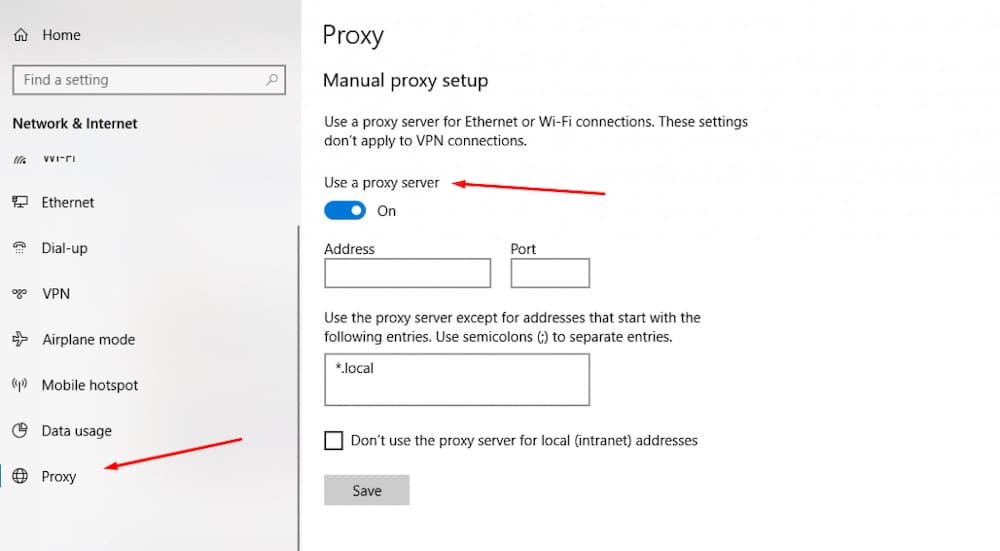
Or you can also go through:
- Control Panel > Network and Internet > Internet Options > Connections “tab” > LAN Settings > Proxy server.

Configure SOCKS5 on uTorrent.
Of course, you can also configure torrent platforms like uTorrent, qBittorrent, or BitTorrent, to use a SOCKS5 proxy server to route its traffic.
To configure a SOCKS5 proxy for Torrenting in uTorrent, go to Preferences > Connection > Proxy Server.

For more information on setting up a proxy for your torrents, check the comprehensive guide to Torrent proxy.
Final Words and Recommendations.
SOCKS5 proxies protect your online anonymity without compromising speed. These proxies are often used to bypass network restrictions, geo-blocks, or censorships. SOCKS5 proxies can also provide a good degree of security if used with authentication and can even go beyond when configured with encryption using protocols like SSH.
Before you go… remember!
- A SOCKS5 proxy is not a VPN. If you are dealing with highly sensitive data, such as banking, trading, etc, bear in mind that SOCKS5 proxies do not encrypt data or re-write any packet header. So, if you are using a shared SOCKS5 proxy server never send sensitive data.
- SOCKS5 proxies travel light. As stated above, SOCKS5 proxies do not encrypt or re-write headers. This makes SOCKS5 travel with less overhead, making their mechanism faster, and less prone to errors than normal VPNs.
- Use SOCKS5 for apps that require speed and reliability. It is recommended to use a SOCKS5 proxy for things that require faster reliable connections (but could go on with a few errors), such as streaming media, P2P, or even online gaming.
- Stay away from free SOCKS5 proxies. The negatives of a free SOCKS5 proxy outweigh the benefits of the “free food”. First, free proxy servers are constantly crowded with all types of users, from good to noisy neighbors. Second, free proxies are generally supported either by showing you tons of ads, by collecting and selling your data, by selling your bandwidth, or even by infecting you with Malware.
A private SOCKS5 proxy, on the other hand, gives you more stability, speed, and fresh IPs that have never been banned or even used before.
from https://www.rapidseedbox.com/blog/guide-to-socks5-proxy
No comments:
Post a Comment